| 1 | A snake of muddy shorelines |
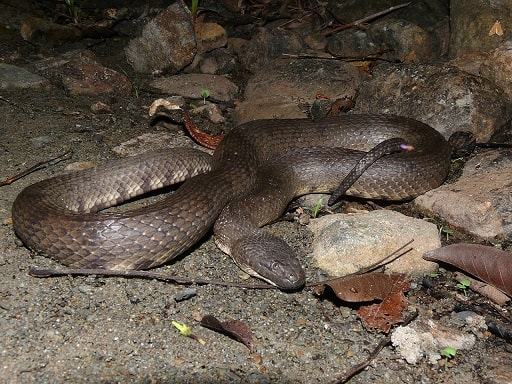
The dog-faced watersnake is a mildly venomous species of Indian coastlines, which has never killed a human. They have semi-aquatic tendencies, and love nothing more than to roll around in cool shoreline mud. Most interestingly, this species has been flying under the radar for decades, as likely one of the most abundant snakes in the world by headcount.
The dog-faced watersnake (Cerberus rynchops) has one of narrowest territories of any snake, not narrow as in confined to a single island, but literally narrow: their territory winds along the entire coast of India, Bangladesh and Myanmar, rarely straying inland by more than a few miles. If you drew their territory on a map, it would probably be snake-shaped itself. This coastline territory stretches for hundreds, even thousands of miles, with only occasional interruptions by major towns and cities.
Dog-faced watersnakes are especially common in estuaries, the more mud the better. Rather than flat featureless beaches, they’re found in areas with a variety of muddy pools and tidal streams, intermingled with plenty of aquatic vegetation where they can disguise themselves, particularly mangrove roots. They venture to the open mud flats between these pools sometimes, but must be careful, as these areas are far more exposed to predators such as white-bellied sea eagles. This video shows an unfortunate dog-faced watersnake encountering a king cobra.
Because they stick to coastlines so closely, dog-faced watersnakes are extremely easy to find. European explorers have known about them since 1799, when they were first described by naturalist Johann Schneider.
| 2 | Dog-faced adaptions |
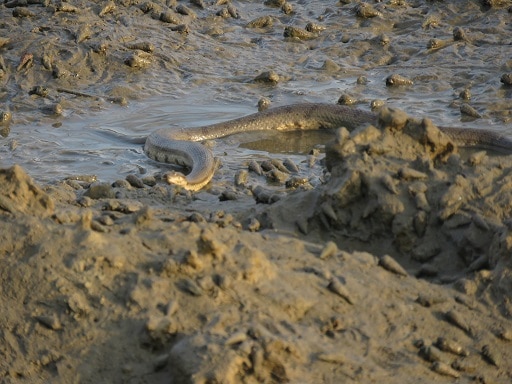
Dog-faced watersnakes aren’t truly aquatic, but a halfway house with several of the adaptions wielded by real sea snakes. The first is a salt gland, located below the upper lip, which absorbs and expels salinity from their bodies. This salt gland is less efficient than fully aquatic snakes, expelling less salt per minute, but is still powerful enough to allow them to live along coasts while cobras watch on enviously. Dog-faced water snakes also have coastal-adapted skin, which has reduced oxygen loss to the atmosphere, and lower water permeability than land-based snakes, again reducing the infiltration of seawater.
Another aquatic feature is their nostrils, which are positioned high on their heads in order to breathe while underwater. These nostrils are partially responsible for their titular dog-faced appearance. It’s not likely that you’d put one on a lead by accident, but this snake has a rounded snout, and round black eyes which fulfil the adorable pet image.
Their colour is also an adaption, being optimal for blending into mud. The dog-faced watersnake is a consistent dark brown to near black, with no noticeable patterns along its back.
| 3 | The world’s first jumping snake |

Cerberus rynchops has one of weirdest skills of any snake: jumping. The first to learn was the camera crew of the BBC’s 2008 series Life In Cold Blood, filming along a muddy tidal flat in Singapore. Amazed viewers watched as a dog-faced watersnake sprung forward without even coiling its body, skipping several feet of mud. It isn’t common for the species, but in the most treacherous, unstable tidal muds, they can leap in a way that defies the laws of biology.
Even their normal movement is unusual, being perfectly adapted to their coastal environments. Dog-faced watersnakes are a rare snake species to sidewind, moving directly sideways rather than forward. They’re rarer still by sidewinding to gain stability on mud – most sidewinders are desert snakes trying to minimise contact with searing sand.
Cerberus rynchops throws its body forward in advance of the head, brings its head and tail level, then rinses and repeats. This leaves recognisable impressions in the mud in their wake, like the J-shaped imprints of a sidewinder rattlesnake; with Cerberus rynchops, they take the form of two parallel tracks.
| 4 | Hijacks the laws of physics |
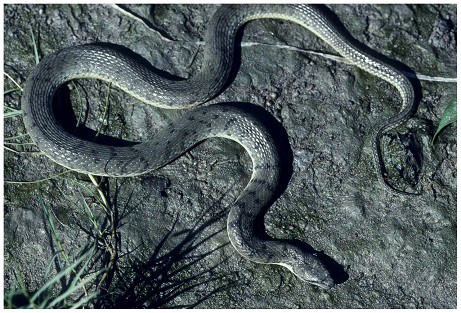
Dog-faced watersnakes have large bulbous eyes, but their eyesight is far from the best among snakes. They live in a murky, silty world, where fish are reduced to blurry objects and rocky walls only become apparent when everything suddenly darkens. The dog-faced watersnake eats fish exclusively, and studies have found that they cannot identify their prey by sight alone. Even if a motionless fish was centimetres from them, the snake would still be unable to lunge for them.
Combining with the mud to ruin all visibility, this is a nocturnal snake, which hunts at night-time exclusively. However experiments have been performed in well-lit tanks, and the dog-faced watersnake still failed to grab a fish using sight when visibility was excellent. Their eyesight is inherently poor rather than simply caused by conditions.
Instead, dog-faced watersnakes tune into the laws of physics, sensing movements in water currents, realising that a fish is coming. They can anticipate the paths of fish based on slight water flow differences, in a way that a human being never could.
| 5 | Eats fish exclusively |
The dog-faced watersnake has a particular taste for two families of fish: the ricefish and the mollies. In a huge study at Sungei Buloh Wetland Reserve in Singapore, covering 1845 prey in total, these made up 54.1% and 35.4% of animals consumed by headcount. 13 other fish families were found in their bellies, but none exceeded 2% of overall prey. Mollies are larger than ricefish, and consequently, they made up by far the highest weight of prey, at 66.48% of the total.
Dog-fished watersnakes also have a tendency to swallow up multiple prey at once. They can swallow up 4 to ricefish, or maybe mix and match species such as 2 mollies, a halfbeak, a mullet and a cichlid. The same study found that female dog-fished watersnakes eat an average of 4.72 fish per meal, and males 4.3. One snake had swallowed 42 tiny ricefish and 4 mollies.
Cerberus rynchops is a mildly venomous species. No symptoms have been observed in humans, but as they chew fish, their pupils sometimes dilate, with a dark mark spreading steadily from the bite site. One fish was released by a dog-faced watersnake and swam around until it died 16.5 minutes later. With particularly large fish such as cichlids, dog-faced watersnakes normally leave the water and rest on muddy shores to commence swallowing.
| 6 | Portion size control |

Dog-faced watersnakes are so sensitive to vibrations that they sometimes attack ripples caused by waterdrops. They’re smart in some ways, as they rarely eat prey anywhere close to their own body weight.
In the Singapore study, the largest prey was a Mayan cichlid weighing 16.48 grams, which was swallowed by a dog-faced watersnake weighing 147.36g. The largest prey relative to body size was another Mayan cichlid, weighing 10.25g versus 48.71mg. That was only 21% of the snake’s own size, which doesn’t approach the lunatic meals of an African rock python (which include crocodiles).
The one thing Cerberus rynchus struggles to suss out is the diameter of the fish it eats. It doesn’t matter how light a fish is; if its head is round, then they can be impossible to get down. One snake with a head diameter of 1.8cm tried to swallow a Mayan cichlid with a diameter of 6.8cm. It spent 30 minutes in a valiant struggle before finally giving up, which was probably for the best.
| 7 | The 270 degree neck twist |
Dog-faced watersnakes can hunt surface-dwelling fish, middle-dwellers and bottom-dwellers all the same, and use varying hunting strategies for each. One is to prowl along the muddy tidal flats, examining pools and probing their heads into burrows to search for gobies and snapping shrimps.
Another is to simply wait on the muddy shores of a pool, waiting for mollies and ricefish to fleck their fins above the water’s surface. They’ll also enter the fray themselves, diving underwater and swimming along the bottoms of pools with their mouths open. The dog-faced watersnake has some intricate manoeuvres for capturing fish. Sometimes, it’s as simple as standing in a school of fish and opening and closing their mouths. But when actually grabbing fish, dog-faced watersnakes always perform a sudden snap of their neck, which tilts their head back at a sickening 270 degree angle.
Furthermore, they keep the fish in a very casual, loose grip with their jaws. With their head bent at an extreme angle, they pin the struggling fish to their neck, so that if it thrashes its way to freedom, its jaws are free to instantly recapture them.
| 8 | Calm and docile |
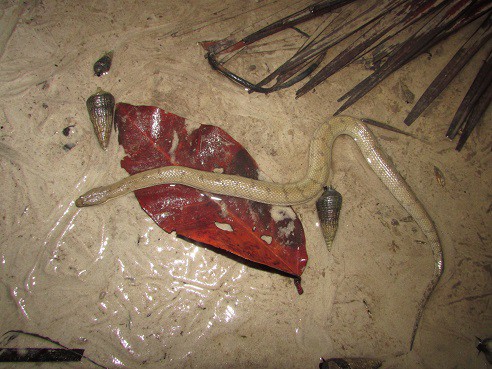
Dog-faced watersnakes have a very calm personality. They reluctantly bite if harassed by humans, chewing on a finger repeatedly, but will show no reaction if you wander past them. This has helped them to gain a foothold in the reptile enthusiast market recently, although their love for fish means that the usual pinkie mice are rejected.
Dog-faced watersnakes aren’t close to endangered, with a “least concern” IUCN tag, but their mangrove habitats are often swallowed up by humanity’s sprawl. Former muddy paradises for this species have been turned into garbage dumps, tourist developments, or polluted mires, causing the snake to vanish without a trace.
The day may come, but dog-faced watersnakes aren’t close to kings of their muddy ecosystems. They’re eaten by mangrove mud crabs, and their Australian relative, Cerberus australis, was once found in the stomach of a tiger shark.
| 9 | The dog-faced lifestyle |
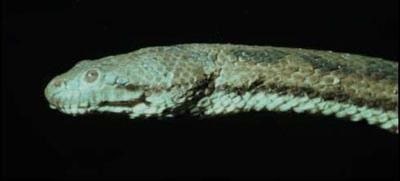
Dog-faced watersnakes are comfortable in their muddy universes and rarely feel the need to seek out a new one. They stay not just in the same muddy tidal flat, but the same muddy pool for months on end.
In a study on 1087 dog-faced watersnakes, 20% were found less than 10 metres away from their original spot 8 months later. If they do seek out a new pool, it tends to be 100-200 metres away, but once they’ve grown tired of that muddy pool, they commonly return to the original one. This snake is intelligent enough to guide itself home using familiar scents and landmarks.
Cerberus rynchops is unusual in that males and females move the same distance in metres per day. In most snakes, males are more adventurous, due to their quest for mates. It’s possible that dog-faced watersnakes are so abundant on muddy tidal flats that males barely have to travel any distance to find their snake soulmate. Dog-faced watersnakes travel long distances occasionally – one travelled 851 metres to a new pool – but they’re mostly a sedentary, comfy snake.
| 10 | The dog-faced family |
Originally, the dog-faced watersnake (Cerberus rynchops) was believed to be the only Cerberus family member, stretching from India to Australia. The first change happened when the Australian colonies were divided into their own, called Cerberus australis. This rules over Australia’s north coast, from West Australia to the Cape York peninsula of Queensland. Cerberus rynchops was then divided into 4 subspecies, but by 2012, DNA analysis had revealed the truth once and for all. The 4 non-Australian species are…
Cerberus rynchops – the coasts of India, Bangladesh, Burma and Thailand as far south as Phuket. Andaman and Nicobar islands.
Cerberus schneiderii – most of Thailand, Malaysia, Indonesia, and the Phillipines.
Cerberus microlepis – extremely rare, found solely in Lake Buhi in the Phillipines.
Cerberus dunsoni – almost as rare, found solely in Palau in Micronesia.
None of the 5 species exist in the same place. Most are hard to distinguish except via subtle scale counts, although C. hudsoni has a black belly and more rounded head scales. Today, the 5-member family is agreed upon by scientists, but the Australian Cerberus australis is more genetically isolated, while the other 4 are closer relatives.
